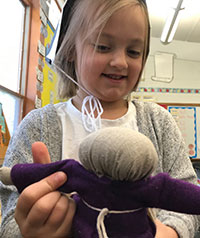In Michelle DeVries’s first-grade class at McFall Elementary School, Lilee Grinnel and Braylee Tep inspected the Indian corncobs soaking in water –- which DeVries hopes to sprout. “Owen’s grandpa gave us this Indian corn,” said Lilee. “It’s wet but kind of cool.”

Jaxson Kozar and Tyler Jackson played around with a slingshot that was used for hunting and playing games in the olden days. Natalie Mason, along with Brooklyn Bennetts and Emilyn Postma, queued for parent volunteer Kate Tep to help tie a white string to her paper Pilgrim bonnet called a coif. Brynleigh Rounds, also wearing a coif, loaded a wooden spoon with tart cranberries.
“Thanksgiving is for celebrating, and at the first Thanksgiving they celebrated for three days,” Braylee Tep shared with her mother, Kate.
DeVries’ class commemorated the First Thanksgiving through the eyes of 7-year-olds who lived in Plymouth, Massachusetts in 1621.
DeVries started with the Mayflower’s voyage across the Atlantic Ocean to the New World, which was populated by the Native Americans who had lived in this land for thousands of years.
“I teach the true meaning of Thanksgiving: to take time and reflect and be thankful for what we have today,” DeVries said. “The first Thanksgiving was a celebration of the harvest and hard work and about people coming together to work hard to form a community.”

For the Thanksgiving study, DeVries looks to create a new community of first-graders and their families who are all invited to the meal and to give thanks for our many blessings, she said.
The students step back in time: churning buttermilk into butter, playing marbles, writing with a feather quill. DeVries’ husband, Lance, cooks a turkey in a trash can while the parents bring along slow-cookers hot with stuffing, mashed potatoes, green beans, and other crowd-pleasing dishes.
Putting food on the table wasn’t so easy in 1621.
“There were no grocery stores or McDonald’s,” DeVries said. “Everything that they ate had to be hunted, fished or gathered.”

Survival at Plymouth Colony
For the Pilgrims, Tisquantum, better known as Squanto, a guide and interpreter from the Patuxet tribe, saved them from sure starvation. “Without Squanto, the Pilgrims wouldn’t have survived,” DeVries told the class, nothing that 45 of the 102 Pilgrim passengers perished that first winter. “It’s an amazing true adventure that shows what bravery, determination and desperation for freedom really look like.”
DeVries told them how Squanto had been kidnapped, brought to Europe and enslaved, learned English and returned to his village to find everyone had died from disease. “Squanto was a big reason the Pilgrims had Thanksgiving, because he taught them how to grow everything,” said student Ben Reaser.
Thanksgiving Table
The Pilgrims didn’t serve pumpkin pie with whipped cream, sweet potatoes with marshmallows or cranberries sweetened with sugar, DeVries told the class. “Here’s what they ate: lots of seafood, lobsters, mussels, and eels because they were close to the Atlantic Ocean.” Also served were venison brought by the Wampanoag people, along with wild turkeys, corn, beans and squash.
DeVries depicts daily life of the time based on her own excursion to Plimoth Plantation, a living museum that replicates the Plymouth Colony.

“If you were a Pilgrim child, you may have had to eat standing up, and after you served the adults,” she told students. “You worked hard alongside your parents, boys with the men and girls with their mother. If you were a Wampanoag Indian boy, you learned to hunt and fish because they didn’t buy food at a grocery store. The girls in the tribe were taught to cook and help grow and gather vegetables.”
DeVries’ concluding her Thanksgiving unit of study with food and games — two similarities that we still share today.
“I see the marbles,” Tyler Jackson whispered to Caleb Brown and Austin Galle. “I wonder when we can play with them.”
CONNECT
Trash can turkey: How to make a Thanksgiving turkey using a garbage can, charcoal and fire














